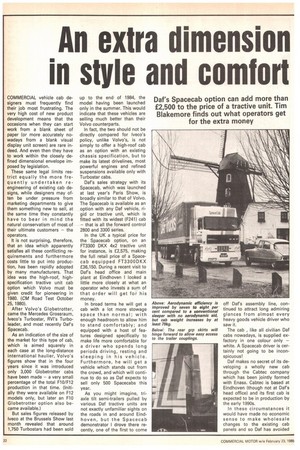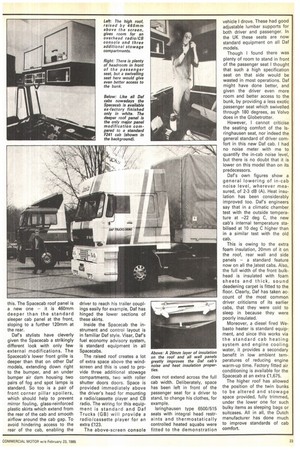An extra dimension in style and comfort
Page 24

Page 25

If you've noticed an error in this article please click here to report it so we can fix it.
Oaf's Spacecab option can add more than £2,500 to the price of a tractive unit. Tim Blakemore finds out what operators get for the extra money
COMMERCIAL vehicle cab designers must frequently find their job most frustrating. The very high cost of new product development means that the occasions when they can start work from a blank sheet of paper (or more accurately nowadays from a blank visual display unit screen) are rare indeed. And even then they have to work within the closely defined dimensional envelope imposed by legislation.
These same legal limits restrict equally the more frequently undertaken reengineering of existing cab designs, while designers may often be under pressure from marketing departments to give them something new to sell, at the same time they constantly have to bear in mind the natural conservatism of most of their ultimate customers — the operators.
It is not surprising, therefore, that an idea which apparently satisfies all these conflicting requirements and furthermore costs little to put into production, has been rapidly adopted by many manufacturers. That idea was the high-roof, highspecification tractive unit cab option which Volvo must be given credit for pioneering in 1980. (CM Road Test October 25, 1980).
After Volvo's Globetrotter, came the Mercedes Grossraum, Iveco's Turbostar, RVI's Turboleader, and most recently Daf's Spacecab.
As an indication of the size of the market for this type of cab, which is aimed squarely in each case at the long-distance international haulier, Volvo's figures show that in the four years since it was introduced only 3,000 Globetrotter cabs have been made — a very small percentage of the total F10/F12 production in that time. (Initially they were available on F12 models only, but later an F10 Globetrotter option also became available.) But sales figures released by Iveco at the Brussels Show last month revealed that around. 1,750 Turbostars had been sold up to the end. of 1984, the model having been launched only in the summer. This would indicate that these vehicles are selling much better than their Volvo counterparts.
In fact, the two should not be directly compared for lveco's policy, unlike Volvo's, is not simply to offer a high-roof cab as an option with an existing chassis specification, but to make its latest drivelines, most powerful engines and refined suspensions available only with Turbostar cabs.
Oaf's sales strategy with its Spacecab, which was launched at last year's Paris Show, is broadly similar to that of Volvo. The Spacecab is available as an option with any Daf vehicle, rigid or tractive unit, which is fitted with its widest (F241) cab — that is all the forward control 2800 and 3300 series.
In the UK a typical price for the Spacecab option, on an FT3300 DKX 4x2 tractive unit for instance, is E2,575, making the full retail price of a Spacecab equipped FT33 OODKX £36,150. During a recent visit to Daf's head office and main plant at Eindhoven I looked a little more closely at what an operator who invests a sum of that order will get for his money.
In broad terms he will get a cab with a lot more stowage space than normal; with enough headroom to allow him to stand comfortably; and equipped with a host of features designed specifically to make life more comfortable for a driver who spends long periods driving, resting and sleeping in his vehicle. Furthermore, he will get a vehicle which stands out from the crowd, and which will continue to do so as Daf expects to sell only 500 Spacecabs this year.
As you might imagine, triaxle tilt semi-trailers pulled by various Daf tractive units are not exactly unfamiliar sights on the roads in and around Eindhoven, but the Spacecab demonstrator I drove there recently, one of the first to come off Oafs assembly line, continued to attract long admiring glances from almost every heavy goods vehicle driver who saw it.
The cab , like all civilian Daf cabs nowadays, is supplied exfactory in one colour only — white. A Spacecab driver is certainly not going to be inconspicuous!
Daf makes no secret of its developing a wholly new cab through the Cabtec company which has been jointly formed with Enasa. Cabtec is based at Eindhoven (though not at Daf's head office) and its first cab is expected to be in production by the early 1990s.
In these circumstances it would have made no economic sense to make wholesale changes to the existing cab panels and so Daf has avoided
this. The Spacecab roof panel is a new one -it is 460mm deeper than the standard sleeper cab panel at the front, sloping to a further 120mm at the rear.
Daf's stylists have cleverly given the Spacecab a strikingly different look with only few external modifications. The Spacecab's lower front grille is deeper than that on other Daf models, extending down right to the bumper, and an under bumper air dam housing two pairs of fog and spot lamps is standard. So too is a pair of front corner pillar spoilers, which should help to prevent mirror fouling, glass-reinforced plastic skirts which extend from the rear of the cab and smooth airflow around the cab gap. To avoid hindering access to the rear of the cab, enabling the driver to reach his trailer couplings easily for example, Daf has hinged the lower sections of these skirts.
Inside the Spacecab the instrument and control layout is in familiar Daf style. Visar, Daf's fuel economy advisory system, is standard equipment in all Spacecabs.
The raised roof creates a lot of extra space above the windscreen and this is used to provide three additional stowage compartments, two with roller shutter doors doors. Space is provided immediately above the driver's head for mounting a radio/cassette player and CB radio. The wiring for this equipment is standard and Daf Trucks (GB) will provide a radio/cassette player for an extra £123.
The above-screen console
does not extend across the full cab width. Deliberately, space has been left in front of the passenger seat for a driver to stand, to change his clothes, for example.
lsringhausen type 6500/515 seats with integral head restraints and thermostatically controlled heated squabs were fitted to the demonstration
vehicle I drove. These had good adjustable lumbar supports for both driver and passenger. In the UK these seats are now standard equipment on all Daf models.
Though I found there was plenty of room to stand in front of the passenger seat I thought that such a high specification seat on that side would be wasted in most operations. Daf might have done better, and given the driver even more room and better access to the bunk, by providing a less exotic passenger seat which swivelled through 180 degrees, as Volvo does in the Globetrotter.
However, I cannot criticise the seating comfort of the Isringhausen seat, nor indeed the general standard of driver comfort in this new Daf cab. I had no noise meter with me to quantify the in-cab noise level, but there is no doubt that it is lower on this model than on its predecessors.
Daf's own figures show a general lowering of in-cab noise level, wherever measured, of 2-3 dB (A). Heat insulation has been considerably improved too. Daf's engineers say that in a climatic chamber test with the outside temperature at —22 deg C, the new cab's internal temperature stabilised at 10 deg C higher than in a similar test with the old cab.
This is owing to the extra foam insulation, 20mm of it on the roof, rear wall and side panels — a standard feature now on all the ,latest cabs. Also, the full width of the front bulkhead is insulated with foam sheets and thick, sound deadening carpet is fitted to the floor. Clearly, Daf has taken account of the most common driver criticisms of its earlier cabs, that they were cold to sleep in because they were poorly insulated.
Moreover, a diesel fired Webasto heater is standard equipment, and since this works via the standard cab heating system and engine cooling water, it provides a secondary benefit in low ambient temperatures of reducing engine warm-up time. Factory fitted air conditioning is available for the Spacecab at an extra £1,675.
The higher roof has allowed the position of the twin bunks to be altered and stowage space provided, fully trimmed, under the lower one for such bulky items as sleeping bags or suitcases. All in all, the Dutch manufacturer has done much to improve standards of cab comfort.




















































































